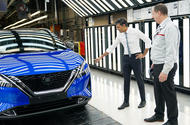Irrespective of the party, campaigns now seem to be part of an infinite game of promises to fix stuff that’s broken
A week into the general election campaign and we await the first real promise – however much of a pinch of salt it should be taken with – to be made about what the automotive industry can expect from a new government after the election on 4 July.
My stalking of Google News headlines hasn’t turned up anything more than a Liberal Democrat candidate being “incensed” by an “electioneering” pledge from the Conservative-run Kent County Council for a ‘Pothole Blitz’ over the summer. Whether that pledge refers to a blitz of potholes being repaired or opened up by another downpour is unclear.
With party manifestos still to be published, it’s left to vague pledges that ultimately all end up sounding the same once you detach the party from the statement. ‘Get Britain building again’, ‘Grow the economy’, increase, cut, reform, scrap.
Election campaigns now seem to be part of an infinite game of promises to fix stuff that’s broken (often ignoring that those promising the fix may have broken it in the first place…), mixed in with often crass patriotism that makes everything far more emotional and divisive than it needs to be.
Serious, sensible, grown-up industries like automotive, with billions in economic wealth for the country linked to them, are more publicly than ever despairing at how to mitigate against chest-beating from under-qualified people making decisions they don’t understand the consequences of.
The banning of the sale of internal-combustion-engined cars in 2035 is a bit more than the tip of the iceberg, yet it illustrates the point perfectly. Take the right or wrong out of it, and just look at the decision making to get to where we are now.
In 2017, it was announced that internal-combustion-engined vehicles would be banned in 2040 by the government as part of its net-zero target in 2050. Three years later, this became 2035, and later in the same year, it was down to 2030. Last year, it went back to 2035. The same political party in government, and three seismic shifts of the goalposts.
Who’s to say we’re not done yet, particularly when the only thing actually enshrined in law is that 80% of new car sales in the UK must be zero-emission by 2030?
That’s just the ultimate decision and policy; then comes the strategy of how to get there, of which there remains no clear long-term one that can be truly separated from the whim of party politics.
No wonder Ineos Automotive CEO Lynn Calder recently claimed it is “very difficult to make decisions” at the moment. She’s just as aware that “it’s therefore very difficult for people to choose a car”.
The automotive industry will enter the election conversation at some point, and perhaps may even be part of manifestos. There will probably be some more cash for potholes. The ban may stay. It might shift. We hope car makers will be encouraged to invest in the UK.
One thing is clear: following the conclusion of July 4’s election, the goalposts must stay fixed.







